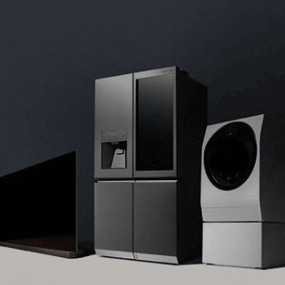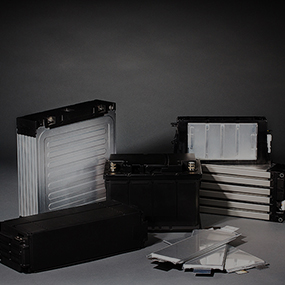LG Innotek
LG Innotek Unveils Flexible Textile Pressure Sensors
2016.08.29LG Innotek today announced a development of new concept textile flexible pressure sensors. This sensor senses pressure from the entire surface of the sensor and it is even bendable. Pressure sensors can measure the level of the external force. Being installed in medical ap-pliances and automobiles to gauge and analyze the pressure, it is used for individual cus-tomized service.
Former commercialized sensors are coin shape and made of PCB substrates or PET films, making them difficult to bend or deform. And it was difficult to measure the pressure uniform-ly from the large area because of its point sensing way. Even it gives feeling of irritation when the sensor touches your body.
LG Innotek's sensors have highly elastic polyurethane material to fit your body comfortably. And its measurement of face pressure distribution by sensing capacitance change caused by pressure. The company has filed thirteen patents regarding the related technologies in South Korea and secured the product quality for mass production in this year. The company’s development of the textile flexible pressure sensors are flexible, making them suitable for products such as gloves and chairs that come in direct contact with the human body.
This new pressure sensor makes it possible to implement new features by utilizing the pres-sure information in various areas such as health care and automotive. In Health-care areas, the sensor helps to improve accuracy of Telemedicine. When the pa-tients wear the device or walk on the carpet, the sensor can detect body balance and acting patterns. The information from the device will automatically be sent to the medical centre If you apply this sensor to your sports gear, you can be served more detailed and improved training service for yourself. For example, the sensor detects the pressure of your hands on the golf club as well as the position of your hands. Then, it sends the information to your smartphone to help you find the perfect grip. You can attach these sensors to automotive for safety and convenience. The sensor under-stands your posture, body type and weight to automatically correct height of car-seat or pressure of airbag. If you apply the sensor to a chair, it measures the pressure on the seat and sends the data to you. You can use this information to correct your posture or analyze your study patterns.
The company developed special polyurethane material that is sensitive to the pressure and has great elasticity, and inserted the material between the electronic fibers. When an external force is applied to the sensor, electric poles inside the fiber detect the deformation to de-termine the pressure. This product is very durable in various environments. It works normally over 240 hours from 40 degrees below zero to 80 above zero. A sensor remains functional even after the average 70-kg man sit on the sensor 100,000 times.
Changhwan Kim, Head of the LG Innotek’s R&D Center said, "We tried to break away from the previous method and attempt new methods to develop innovative products." He also said, “We will continue to develop materials and components in various fields to provide new experiences to our customers." According to BBC Research & Consulting, a global market research institute, the global pressure sensor market is expected to grow from USD 11.5 billion in 2014 to USD 16.3 billion in 2019. The annual average growth rate is expected to be 7.2% between 2014 and 2019.
Former commercialized sensors are coin shape and made of PCB substrates or PET films, making them difficult to bend or deform. And it was difficult to measure the pressure uniform-ly from the large area because of its point sensing way. Even it gives feeling of irritation when the sensor touches your body.
LG Innotek's sensors have highly elastic polyurethane material to fit your body comfortably. And its measurement of face pressure distribution by sensing capacitance change caused by pressure. The company has filed thirteen patents regarding the related technologies in South Korea and secured the product quality for mass production in this year. The company’s development of the textile flexible pressure sensors are flexible, making them suitable for products such as gloves and chairs that come in direct contact with the human body.
This new pressure sensor makes it possible to implement new features by utilizing the pres-sure information in various areas such as health care and automotive. In Health-care areas, the sensor helps to improve accuracy of Telemedicine. When the pa-tients wear the device or walk on the carpet, the sensor can detect body balance and acting patterns. The information from the device will automatically be sent to the medical centre If you apply this sensor to your sports gear, you can be served more detailed and improved training service for yourself. For example, the sensor detects the pressure of your hands on the golf club as well as the position of your hands. Then, it sends the information to your smartphone to help you find the perfect grip. You can attach these sensors to automotive for safety and convenience. The sensor under-stands your posture, body type and weight to automatically correct height of car-seat or pressure of airbag. If you apply the sensor to a chair, it measures the pressure on the seat and sends the data to you. You can use this information to correct your posture or analyze your study patterns.
The company developed special polyurethane material that is sensitive to the pressure and has great elasticity, and inserted the material between the electronic fibers. When an external force is applied to the sensor, electric poles inside the fiber detect the deformation to de-termine the pressure. This product is very durable in various environments. It works normally over 240 hours from 40 degrees below zero to 80 above zero. A sensor remains functional even after the average 70-kg man sit on the sensor 100,000 times.
Changhwan Kim, Head of the LG Innotek’s R&D Center said, "We tried to break away from the previous method and attempt new methods to develop innovative products." He also said, “We will continue to develop materials and components in various fields to provide new experiences to our customers." According to BBC Research & Consulting, a global market research institute, the global pressure sensor market is expected to grow from USD 11.5 billion in 2014 to USD 16.3 billion in 2019. The annual average growth rate is expected to be 7.2% between 2014 and 2019.














